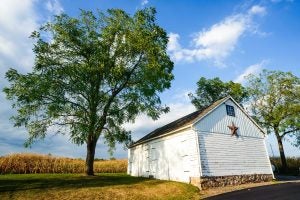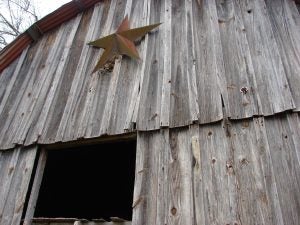There are few symbols more Americana than a rustic wood or metal star brandished on a home, barn, or shop. While they’ve certainly been melted down into something somewhat culturally homogenous in this great American pot, they’re originally associated with midwestern Dutch heritage and architecture.
Being colorful and bold — yet oddly simple — it’s easy to see why they’ve been adopted as an ideal rustic statement piece. But have you ever considered exactly where this country home staple came from?
The barn star is certainly historic, but there are many interpretations of their exact origins and meanings. Safe to say, these symbols adorned barns and homes regularly from the 1700s to 1820s — a mainstay among the Pennsylvania Dutch communities. After the Civil War, the stars seemed to proliferate even further
Some of them may very well have just been a decorative choice, but history buffs have uncovered deeper significance.

What’s in a star?
The types of stars seem to have changed over the years. Original designs usually had only three or four points, with five points eventually becoming the norm. While today’s stars are usually wood or metal work and attached to structures, some early buildings actually have these pieces built directly into the architecture.
Experts note some traditional stars are a type of builder’s mark or purely ornamental as opposed to having religious or superstitious meaning. In fact, historians have traced specific star designs to individual Pennsylvania barn builders and their families. Think of it as a sort of early branding or trademark.
Religious and superstitious symbolism
The early Germanic, Swedish, and Dutch settlers who spread their roots in the Pennsylvania region brought with them an incredibly rich heritage and religious culture. These were so deeply rooted; the influence can be seen very distinctly in many Amish and old ethnic communities to this day.
Part of that are the various “hex signs” that are prominent in artwork and home staples. These can get lumped into the barn star identity — and the lines get a little blurry here.
The settlers (referring to the “Fancy Dutch” as opposed to the “Plain” Amish and Mennonite faiths) brought with them a colorful religious symbolism laced with some superstition. Amid the barn stars and barn quilts are what’s referred to as “hex signs” and have origins in some of the ancient pagan religions.
These can be seen in a variety of different patterns and symbols on barns — many of which incorporate stars. The context and placement are important to be considered, but traditionally hex symbols and star shapes on buildings incorporate a spectrum of different colors tied to different meanings — at least in a historical light.

Even if not part of a specific hex, the color of certain barn stars may indicate the intent. Here are some examples.
Black: Protection by the binding or mixing elements or curses
White: Purity and energy
Yellow: Health and godliness
Blue: Spirituality and peace
Brown: Earth and strength
Green: Fertility, growth and successfulness
Orange: Prosperity
Red: Emotions, passion and creativity
Violet: Sacredness
Often these hexes incorporate star shapes, rosettes, and even animal shapes to signify different things.
Of course, as with anything obscured by time and tradition, there is some debate about exactly how much meaning is tied to different Dutch symbols and art that grace homes, barns, and other farm buildings.
Some people point to certain shapes and designs as having a strictly biblical significance, others cite them, in some cases, as being personal decorative preference.
Regardless of all the specificities of their origins, today’s humble barn décor has taken on a life all its own and truly become a staple in Americana design. Just another great example of the legendary rural American melting pot at work!
Jaclyn Krymowski is a recent graduate of The Ohio State University with a major in animal industries and minor in agriculture communications. She is an enthusiastic “agvocate,” professional freelance writer, and blogs at the-herdbook.com.



